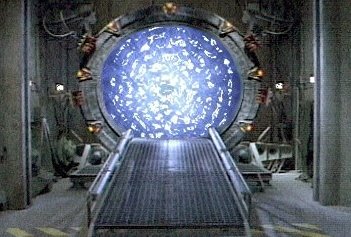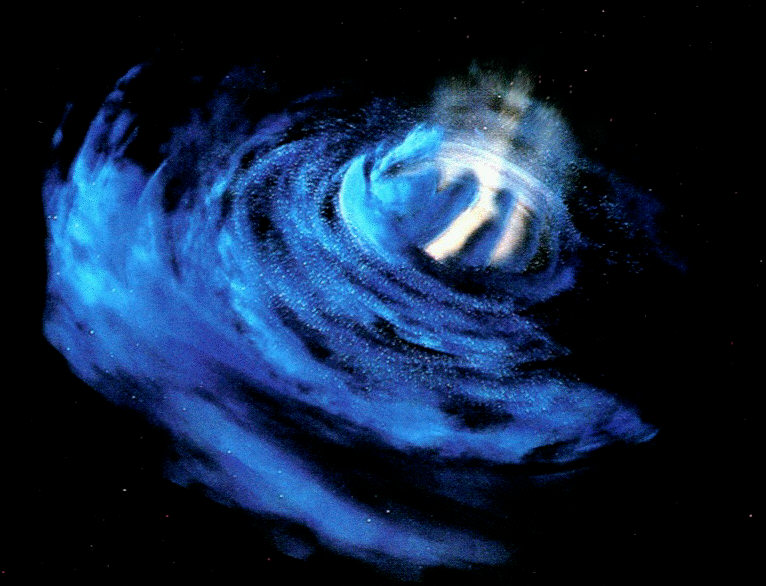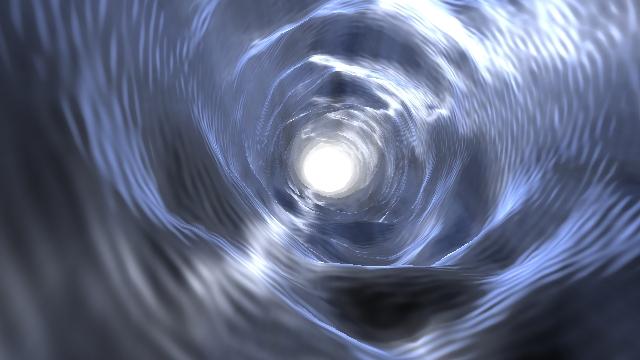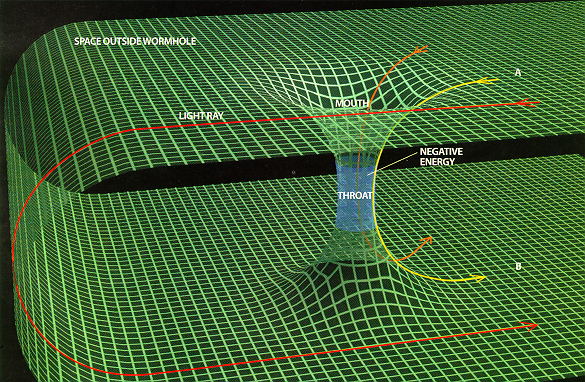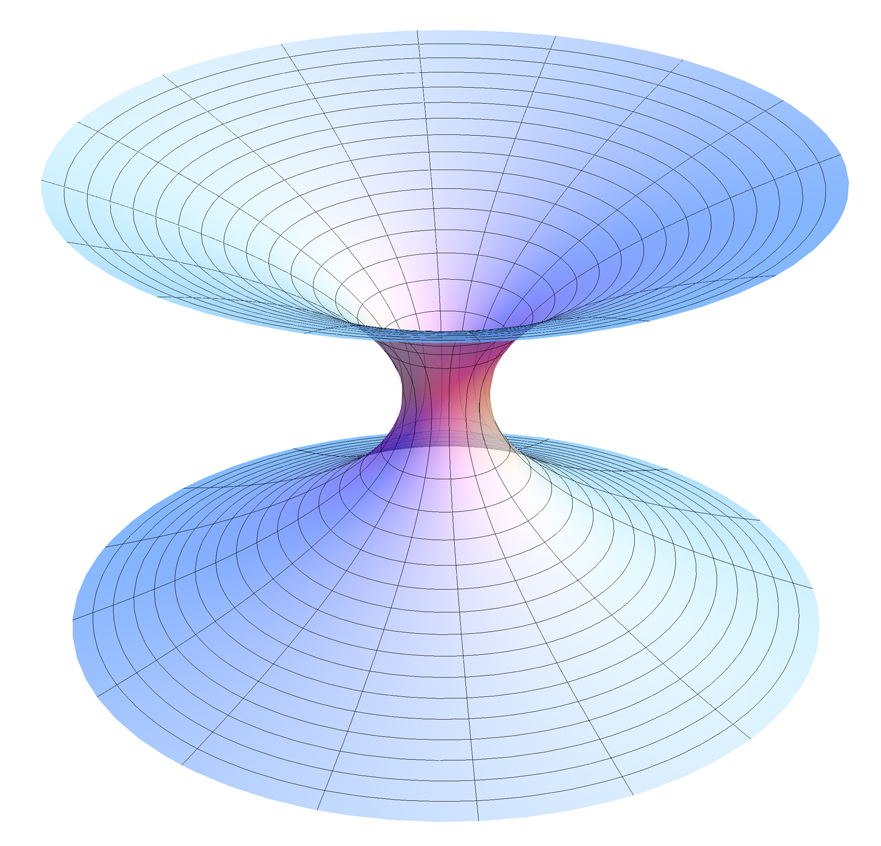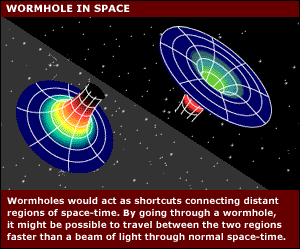| STAR GATE
Wormholes |
||
|
Wormhole Physics 101
To Read the rest of this paper please visit Wormhole Physics 101 - by The Stargate SG-1 Role playing Game |
||
|
...
The Bajoran Wormhole From Star Trek: Deep Space Nine Wormholes are a popular feature of science fiction as they allow interstellar travel within human time scales. It is common for the creators of a fictional universe to decide that faster-than-light travel is either impossible or that the technology does not yet exist, but to use wormholes as a means of allowing humans to travel long distances in short time periods. Military science fiction (such as Babylon 5) often use a "jump drive" to propel a spacecraft between two fixed "jump points" connecting solar systems. Connecting solar systems in a network like this results in a fixed "terrain" with choke points that can be useful for constructing plots related to military campaigns. The Alderson points postulated by Larry Niven and Jerry Pournelle in Mote in God's Eye and related novels is an especially well thought out example. The development process is described by Niven in N-Space, a volume of collected works. David Weber has also used the device in the Honorverse and other books such as those based upon the Starfire universe, and has described a 'history' of development and exploitation in several essays in collections of related short stories. Naturally occurring wormholes form the basis for interstellar travel in Lois McMaster Bujold's Vorkosigan Saga; the world of Barrayar was isolated from the rest of human civilization for centuries after the connecting wormhole collapsed, until a new route was discovered, and they are the frequent subject of political plots and military campaigns. They are also used to create an Interstellar Commonwealth in Peter F. Hamilton's Commonwealth Saga. Wormholes feature prominently in the television series Farscape. They are the cause of John Crichton's presence in the alien universe, as well as the reason for many of the events that subsequently take place. In Stargate SG-1 and Stargate Atlantis, a wormhole is created by a Stargate, and as opposed to other science fiction programs, many of the technical issues facing wormhole travel are addressed. Wormholes are a common feature in the computer game Elite in which they are short lived constructs created on demand by the hyper drive as a means of interstellar transport. SOURCE: Wikipedia |
||
This image was produced by Arrghman at the Lightwave Tutorial Group as part of a demo on how to create wormhole animation. A copy of the Final Animation is on their website SEE ALSO: Wormhole Artwork |
||
3D Analogy to a Wormhole Realistic view of a wormhole
as seen by an observer crossing the horizon of a
Schwarzschild black hole.
The observer originates from the right, and
another universe becomes visible
in the center of the black hole shadow once the
horizon is crossed. This
new region is however unreachable in the case of
a Schwarzschild black
hole, and will disappear in an infinite red
shift as the observer ultimately
hits the singularity.
In physics, a wormhole (also known as Abbreviated Space) is a hypothetical topological feature of space time that is essentially a "shortcut" or "abbreviation" through space and time. A wormhole has at least two mouths which are connected to a single throat. If the wormhole is traversable, matter can 'travel' from one mouth to the other by passing through the throat. The name "wormhole" comes from an analogy used to explain the phenomenon. If a worm is traveling over the skin of an apple, then the worm could take a shortcut to the opposite side of the apple's skin by burrowing through its center, rather than traveling the entire distance around, just as a wormhole traveler could take a shortcut to the opposite side of the universe through a hole in higher dimensional space. Definition There is a compact region of space time whose boundary is topologically trivial but whose interior is not simply connected. Formalizing this idea leads to definitions such as the following, taken from Matt Visser's Lorentzian Wormholes: If a Lorentzian space time contains a compact region ?, and if the topology of ? is of the form ? ~ R x ?, where ? is a three manifold of nontrivial topology, whose boundary has topology of the form d? ~ S˛, and if furthermore the hyper surfaces ? are all space like, then the region ? contains a quasi permanent inter universe wormhole. Characterizing
inter universe wormholes is more difficult.
For example, one can imagine a 'baby' universe
connected to its 'parent'
by a narrow 'umbilicus'. One might like to regard
the umbilicus as the
throat of a wormhole, but the space time is simply
connected.
Wormhole types Inter universe wormholes connect one location of a universe to another location of the same universe (in the same present time). A wormhole should be able to connect distant locations in the universe by bending space time, allowing travel between them that is faster than it would take light to make the journey through normal space. See the image above. Inter universe wormholes connect one universe with another [1], [2]. This gives rise to the speculation that such wormholes could be used to travel from one parallel universe to another. A wormhole which connects (usually closed) universes is often called a Schwarzschild wormhole. Another application of a wormhole might be time travel. In that case it is a shortcut from one point in space and time to another. In string theory a wormhole has been envisioned to connect two D-branes, where the mouths are attached to the branes and are connected by a flux tube [3]. Finally, wormholes are believed to be a part of space time foam [4]. There are two main types of wormholes: Lorentzian wormholes and Euclidean wormholes. Lorentzian wormholes are mainly studied in semi classical gravity and Euclidean wormholes are studied in particle physics. Traversable wormholes are a special kind of Lorentzian wormholes which would allow a human to travel from one side of the wormhole to the other. Sergey Krasnikov tossed the term space time shortcut as a more general term for (traversable) wormholes and propulsion systems like the Alcubierre drive and the Krasnikov tube to indicate hyper fast interstellar travel. Theoretical basis It is unknown whether (Lorentzian) wormholes are possible or not within the framework of general relativity. Most known solutions of general relativity which allow for wormholes require the existence of exotic matter, a theoretical substance which has negative energy density. However, it has not been mathematically proven that this is an absolute requirement for wormholes, nor has it been established that exotic matter cannot exist. Recently Amos Ori envisioned a wormhole which allowed time travel, did not require any exotic matter, and satisfied the weak, dominant, and strong energy conditions [5]. Since there is no established theory of quantum gravity, it is impossible to say with any certainty whether wormholes are possible or not within that theoretical framework. Traversable wormholes Lorentzian traversable wormholes would allow travel from one part of the universe to another part of that same universe very quickly or would allow travel from one universe to another universe. Wormholes connect two points in space time, which means that they would allow travel in time as well as in space. Wormholes and faster-than-light space travel Often there is confusion about the idea that wormholes allow super luminal (faster-than-light) space travel. In fact there is no real super luminal travel involved. Assume that the wormhole connects two remote locations. While traveling through a wormhole, sub luminal (slower-than-light) speeds can be used. The time in which the distance was traveled would appear faster (due to the fact that it goes through a line (a-b) in a curved space instead of going through space outside of the wormhole, which is like going through the center of an apple rather than going around it on the outside, hence the name wormhole) than it would take light to make the journey through normal space. In other words, while you might need to run to get around a mountain in a certain time, you can walk comfortably if there is a tunnel through the center; no additional speed is needed, because the subjective distance is shorter. Wormholes and time travel A wormhole could allow time travel. This could be accomplished by accelerating one end of the wormhole relative to the other, and then sometime later bringing it back; relativistic time dilation would result in less time having passed for the accelerated wormhole mouth compared with the stationary one, meaning that anything which entered the stationary wormhole mouth would exit the accelerated one at a point in time prior to its entry. The path through such a wormhole is called a closed time like curve, and a wormhole with this property is sometimes referred to as a "time hole." It is thought that it may not be possible to convert a wormhole into a time machine in this manner, some mathematical models indicate that a feedback loop of virtual particles would circulate through the time hole with ever increasing intensity, destroying it before any information could be passed through it. This has been called into question by the suggestion that radiation would disperse after traveling through the wormhole, therefore preventing infinite accumulation. There is also the Roman ring, which is a very stable configuration of more than one wormhole. This ring allows a closed time loop with stable wormholes. The debate on this matter is described by Kip S. Thorne in the book Black Holes and Censorship Hypothesis.
Wormholes known as Schwarzschild wormholes or Einstein-Rosen bridges are bridges between areas of space that can be modeled as vacuum solutions to the Einstein field equations by sticking a model of a black hole and a model of a white hole together. However, this type of wormhole is unstable enough to pinch off instantly as soon as it forms. While the equations of General Relativity suggest that a Schwarzschild wormhole could be stabilized by holding its "throat" open with exotic matter (material that has negative mass), it would still be impossible for a traveler to go through this type of wormhole because they can only go through an event horizon in one direction, and both ends of the hole have an event horizon. This leaves the traveler trapped in the middle of the wormhole. Before the stability problems of Schwarzschild wormholes were apparent, it was proposed that quasars were white holes forming the ends of wormholes of this type. Wormhole metrics Theories of wormhole metrics describe the space time geometry of a wormhole and serve as theoretical models for time travel. A simple example of a (traversable) wormhole metric is the following: ds^2= - c^2 dt^2 + dl^2 + (k^2 + l^2)(d \theta^2 + \sin^2 \theta \, d\phi^2) One type of non traversable wormhole metric is the Schwarzschild solution: ds^2= - (1 - \frac{2GM}{rc^2})dt^2 + \frac{dr^2}{1 - \frac{2GM}{rc^2}} + r^2(d \theta^2 + \sin^2 \theta \, d\phi^2) As a tear in space time If we consider space time (with masses causing warps in it) and accept that gravity waves are possible, which modern physics does, it would be possible to shear space time so much that it would tear, albeit using impossible materials. Taking a torus of neutronium (material with the density of a neutron star) roughly 1 astronomical unit in diameter and raising it to several exavolts static charge would cause a massive disruption in space time. If the experimenter was to then spin this torus to give the outside edge an angular velocity measurable in percentages of c then space time within the torus should then twist, and tear. Where or even if it would "appear" on the "other end" is open to speculation. Naturally, the problems of such a device are insurmountable. Such a massive amount of neutronium would instantly collapse and cause a very energetic rebound of its own gravitational energy, perhaps exceeding the power output of a supernova. It follows that the builders must have expended that much energy in creating the device to begin with. It may be possible that such wormholes, as tears in space time, occur naturally. The coalescing of two black holes or neutron stars should give similar conditions in the seconds before their merging. SOURCE: Wikipedia
|
||
New calculations suggest that wormholes large and stable enough to allow intergalactic travel really can exist. The possibility that the cosmos is peppered with wormholes, short cuts through space and time, has long intrigued scientists. Current models, based on Einstein's general theory of relativity, suggest that only tiny quantum sized wormholes may exist. A type of negative energy filling, known as "exotic matter", keeps them open. However, the difficulty of producing exotic matter limits the size of wormholes to the sub-atomic scale. Now, says New Scientist magazine, a Russian theorist has come up with a calculation for a large, stable wormhole that is compatible with the known laws of physics. Energy supply According to Sergei Krasnikov of the Pulkovo Observatory in St. Petersburg, the new wormhole can create its own abundant supply of exotic matter. This way, the wormhole would be big enough and could stay open long enough for people to use. - B SOURCE-
BBC
News
|
||
| FAIR USE NOTICE: This page contains copyrighted material the use of which has not been specifically authorized by the copyright owner. Pegasus Research Consortium distributes this material without profit to those who have expressed a prior interest in receiving the included information for research and educational purposes. We believe this constitutes a fair use of any such copyrighted material as provided for in 17 U.S.C § 107. If you wish to use copyrighted material from this site for purposes of your own that go beyond fair use, you must obtain permission from the copyright owner. | ||
| ~ MENU ~ |
